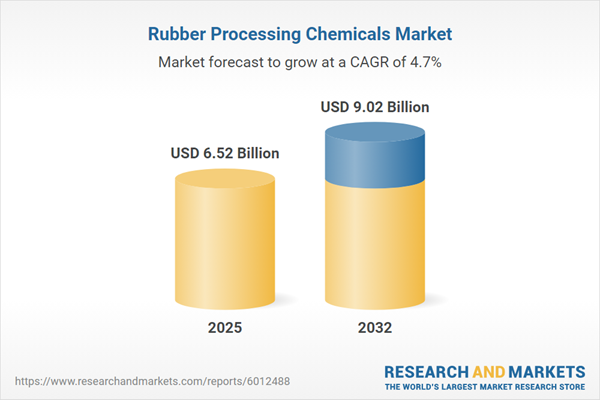Speak directly to the analyst to clarify any post sales queries you may have.
Senior leaders in the rubber processing chemicals market are navigating an industry shaped by accelerating sustainability targets, intensifying regulatory complexity, and a rising demand for digital transformation. In this climate, access to reliable market intelligence is critical for responsive decision-making and managing emerging risks.
Market Snapshot: Rubber Processing Chemicals Market Size, Growth, and Outlook
The global rubber processing chemicals market is forecast to expand from USD 6.23 billion in 2024 to USD 6.52 billion by 2025, with an anticipated USD 9.02 billion milestone projected by 2032. This growth reflects a compound annual growth rate (CAGR) of 4.72%. Key factors shaping sector momentum include evolving regulatory frameworks, greater digital investment, and increasing focus on sustainable supply chains. Companies are working to meet rising compliance requirements, reinforce operational continuity, and drive R&D innovation. Market participants are aligning production systems with agile, flexible models to address changing end-user demands and market volatility.
Scope & Segmentation in the Rubber Processing Chemicals Market
This research delivers practical insights tailored for executive leadership, with a segmentation strategy that supports high-level planning and competitive positioning across the market lifecycle. The framework identifies key operational, technological, and regulatory dynamics across all major segments and regions:
- Application: Addresses footwear, industrial products, hoses and belts, conveyor systems, extrusion profiles, seals and gaskets, tires, and tubes, each requiring specialized formulations for durability, longevity, and performance.
- Product Type: Includes accelerators, activators, adhesives, tackifiers, antioxidants, fillers, plasticizers, stearic acid, sulfur, sulfur donors, and zinc oxide, each aligned with manufacturing quality and regulatory requirements.
- End-Use Industry: Covers automotive, construction, consumer products, energy and power, and a range of industrial sectors where innovation, efficiency, and cost management are critical.
- Raw Material Source: Evaluates both natural and synthetic feedstock strategies, impacting production flexibility and long-term sustainability targets.
- Form: Encompasses emulsion, granule, liquid, and powder forms, each contributing to operational scalability and adaptability to customization requirements.
- Distribution Channel: Reviews direct sales, distributor networks, and digital procurement, considering their roles in enhancing procurement efficiency and supplier engagement.
- Geography: Examines the Americas, Europe, Middle East, Africa, and Asia-Pacific, with focused analysis on China, India, Japan, and Southeast Asia, taking into account varied regulatory standards, manufacturing hubs, and innovation dynamics.
- Leading Companies Analyzed: Features profiles of LANXESS AG, BASF SE, Evonik Industries AG, Eastman Chemical Company, Solvay SA, SI Group, Inc., CHT Group, Tosoh Corporation, Schill + Seilacher GmbH, and Nouryon B.V., offering insights into technology leadership and competitive strategies.
Key Takeaways for Senior Decision-Makers
- Advance environmental goals by integrating green chemistry practices and expanding reliance on alternative feedstocks, facilitating regulatory compliance and strong supplier relationships.
- Accelerate digital transformation by applying automation and advanced analytics throughout manufacturing, enabling efficient resource use and data-driven operations.
- Adapt procurement strategies using flexible sourcing models and robust inventory management, supporting resilience amid fluctuating supply dynamics and policy changes.
- Prioritize investments in R&D for eco-friendly accelerators, bio-based plasticizers, and next-generation adhesives to enhance equipment performance and process efficiency.
- Adopt multi-channel procurement, emphasizing digital platforms for supplier collaboration and regulatory adaptability in the sourcing process.
Tariff Impact: Navigating U.S. Regulatory Shifts
Recent changes in U.S. tariffs on rubber processing chemicals have led companies to reassess sourcing and inventory measures to address emerging risk factors. Firms are adopting more local procurement strategies, reformulating products to comply with updated domestic standards, and increasing inventory levels to secure supply. Maintaining transparency across the supply chain has become essential for effective risk mitigation and enabling prompt responses to regulatory adjustments.
Methodology & Data Sources
This market analysis brings together findings from executive interviews, industry-specific surveys, technical literature reviews, regulatory assessments, and proprietary data resources. Strategic models, including SWOT and Porter’s Five Forces, strengthen the foundation for actionable recommendations.
Why This Report Matters: Strategic Value in the Rubber Processing Chemicals Market
- Clarifies the interplay of shifting regulations, digital transformation, and sustainable sourcing, helping leaders implement agile market strategies tailored to operational realities.
- Delivers segmented market insight and regional perspectives to enable effective benchmarking and strategic planning for executive initiatives.
- Prepares organizations to anticipate and address regulatory changes and tariff effects, underpinning risk management and continuity of supply.
Conclusion
With industry transformation accelerating, access to robust market intelligence is essential for building adaptable, resilient organizations. This research empowers leaders to make informed decisions and sustain competitive growth.
Additional Product Information:
- Purchase of this report includes 1 year online access with quarterly updates.
- This report can be updated on request. Please contact our Customer Experience team using the Ask a Question widget on our website.
Table of Contents
3. Executive Summary
4. Market Overview
7. Cumulative Impact of Artificial Intelligence 2025
Companies Mentioned
The companies profiled in this Rubber Processing Chemicals market report include:- LANXESS AG
- BASF SE
- Evonik Industries AG
- Eastman Chemical Company
- Solvay SA
- SI Group, Inc.
- CHT Group
- Tosoh Corporation
- Schill + Seilacher GmbH
- Nouryon B.V.
Table Information
| Report Attribute | Details |
|---|---|
| No. of Pages | 181 |
| Published | October 2025 |
| Forecast Period | 2025 - 2032 |
| Estimated Market Value ( USD | $ 6.52 Billion |
| Forecasted Market Value ( USD | $ 9.02 Billion |
| Compound Annual Growth Rate | 4.7% |
| Regions Covered | Global |
| No. of Companies Mentioned | 11 |









